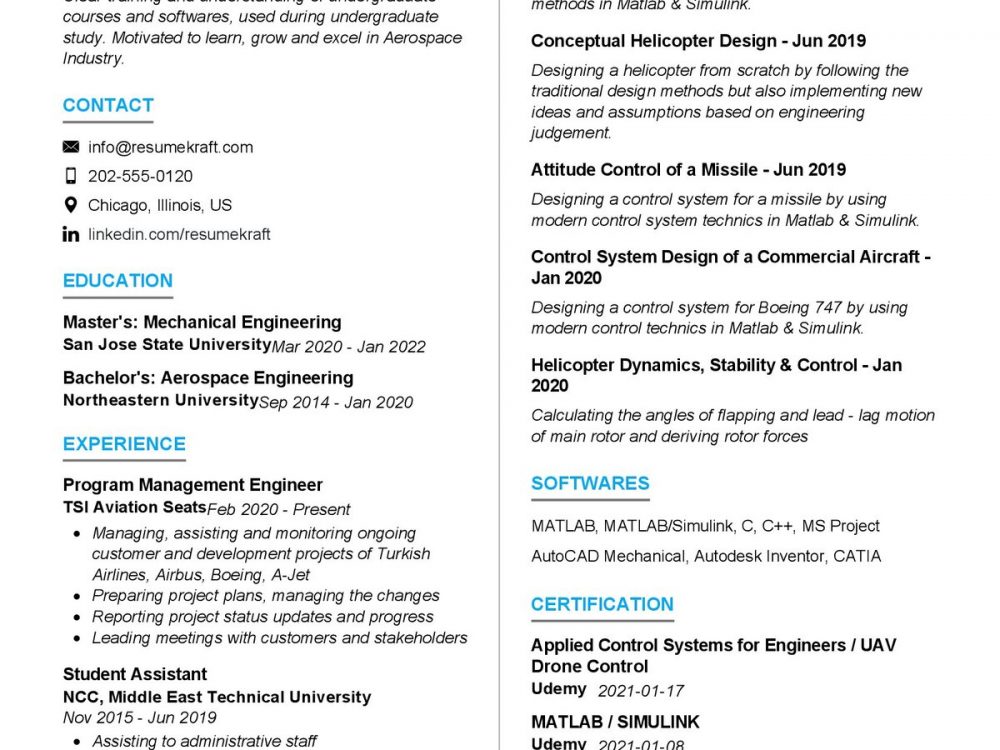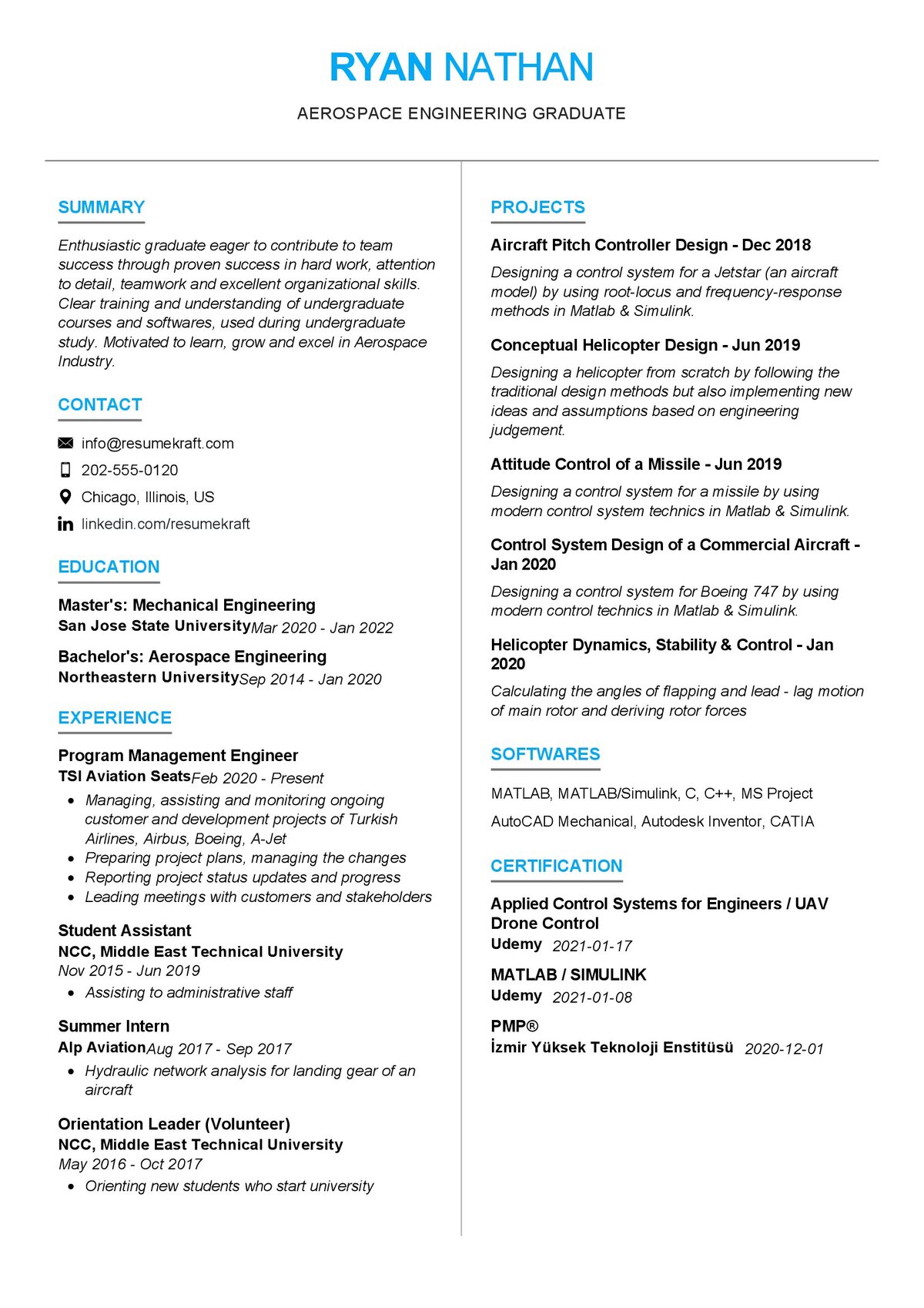What Should Be Included In A Aerospace Engineering Resume?
When writing an Aerospace Engineering resume, there are certain components that should not be overlooked. It is important to include your education, skills, experience, and any applicable certifications to show employers that you are a qualified candidate for the position.
Starting with your education, it is important to include your degree, school and date of graduation, any special certifications, and any relevant coursework that you have taken. This should be placed at the top of your resume, and should include any honors or awards that you have received.
Next, you should list your skills and qualifications. This should include specific aerospace engineering abilities, such as design and fabrication, numerical analysis, and aerospace systems. It is also important to include any relevant experience that you have, such as any internships or research projects.
Finally, it is important to list any certifications or licenses that are relevant to aerospace engineering. This includes, but is not limited to, certification from ASTM International and the Professional Engineers of Ontario. If you have received any awards or certificates related to aerospace engineering, you should also include those.
By following these tips, you can be sure that your Aerospace Engineering resume will be impressive and effective in demonstrating your qualifications for the position. Remember to be honest and to highlight your skills, qualifications, and any awards or certifications that you have received. With the right combination of education, experience, and certifications, you can be sure that your Aerospace Engineering resume will stand out from the competition and get you the job you want.
What Skills Should I Put On My Resume For Aerospace Engineering?
Aerospace engineering is a highly specialized field, so when creating an aerospace engineering resume, it is important to include the right skill set to ensure success. When drafting a resume for an aerospace engineering position, there are certain skills that employers look for. These skills can include technical skills, such as engineering design, analysis, and problem solving. Additionally, employers also look for strong communication skills, such as the ability to explain technical concepts to non-technical audiences. Other essential skills include the ability to plan, coordinate, and manage projects, as well as the ability to work independently. Finally, employers often value experience in relevant fields, such as aviation, aviation systems, and aircraft maintenance.
Including a well-rounded set of skills on your aerospace engineering resume is a great way to demonstrate your qualifications and to stand out from the competition. To ensure that your resume is as successful as possible, it is important to carefully consider the skills that you include. When selecting the skills to list on your resume, tailor them to the particular aerospace engineering position that you are applying for and make sure to emphasize the most relevant skills. With a well-crafted resume, you can showcase your qualifications and demonstrate that you are the ideal candidate for the position.
What Is The Job Description Of The Aerospace Engineering?
Aerospace engineers are responsible for the design, development, testing, and launch of aircraft, missiles, and spacecraft. They are also involved in research and development, troubleshooting, and conducting investigations into accidents and other malfunctions. For aerospace engineers, the primary goal is to create advanced technologies that are safe, efficient, and innovative.
When it comes to job tasks, aerospace engineers typically work on designing aircraft, missiles, and spacecraft. Additionally, they are involved in project management, budgeting, and scheduling tasks. They also often lead teams of other engineers and technicians, supervising and directing the development of projects. Furthermore, aerospace engineers may be involved in testing and research, as well as safety and regulatory compliance.
Aerospace engineers must have a sound knowledge of physics, mathematics, materials science, and aerodynamics. They must be able to understand complex systems, develop solutions to technical problems, and conduct investigations into malfunctions. Additionally, they must be able to communicate effectively with other engineering professionals.
Aerospace engineering is an exciting and rewarding field that offers a great deal of potential for growth. If you are interested in pursuing a career in aerospace engineering, you should consider developing your skillset through coursework, internships, and other relevant experiences. A strong resume can help you demonstrate your qualifications and stand out among other candidates.
What Is A Good Objective For A Aerospace Engineering Resume?
A good objective for a aerospace engineering resume is to demonstrate an understanding of the principles and techniques of aerospace engineering and the ability to apply them to the design, development, and implementation of aerospace systems and products. Additionally, the objective should emphasize the applicant’s ability to work collaboratively in a team environment, stay current with emerging technologies, and manage complex projects.
It should clearly demonstrate why you are the perfect candidate for the job, highlighting your key skills and qualifications that make you stand out from other applicants. When writing your aerospace engineering resume objective, focus on your technical abilities and knowledge, demonstrating your understanding of the industry and your drive to succeed in this field. Additionally, include any specialties or certifications you may have, as well as any notable successes in your past projects that are applicable to the job. A well-crafted aerospace engineering resume objective should give potential employers an idea of your competency and enthusiasm for the job.
What Are The Career Prospects In The Aerospace Engineering?
A career in aerospace engineering is one of the most sought-after and rewarding professions. It involves designing aircraft, spacecraft, missiles and satellites, and creating propulsion and navigation systems. Professionals in this field are responsible for creating the safest and most efficient methods of flight.
Aerospace engineering offers a wide range of career prospects, from designing aircraft and spacecraft to developing cutting-edge propulsion and navigation systems. Aerospace engineers are responsible for designing, testing and incorporating new technologies into aircraft, satellites and other related technologies.
The job outlook for aerospace engineering is very positive, with a projected growth rate of 5% from 2018 to 2028. This growth is expected to be driven by a demand for new and more efficient aircraft, as well as a need for new communication systems, such as satellites. Additionally, the advancement of technologies like autonomous flight and unmanned aerial vehicles (UAVs) will also be a factor.
Those interested in working in this field should note that it requires a strong educational background in engineering and mathematics, as well as a good understanding of aeronautics. Having a good knowledge of the physics of flight, as well as the principles of aircraft design and operation, are also required. Additionally, aerospace engineers should have a good knowledge of materials and manufacturing processes, as well as experience with computer-aided design (CAD) and engineering software.
Overall, aerospace engineering offers a wide range of career prospects and is a great choice for those interested in developing innovative solutions for the aerospace industry. With the growing demand for new aircraft, spacecraft, missiles and satellites, aerospace engineers will continue to be in high demand.
Key Takeaways for an Aerospace Engineering resume
When writing an aerospace engineering resume, there are several key takeaways to keep in mind. The first is to ensure that the resume accurately reflects the skills and knowledge that you have acquired while working in the industry. It is also important to keep the resume organized and concise, showcasing your experience, qualifications, and relevant certifications.
It is important to emphasize any relevant work experience with computer-aided design (CAD) and engineering software, as well as any special training or certifications that you have obtained. Finally, make sure to include any research or development projects you have participated in, as these can provide employers with valuable insight into your technical capabilities.
Additionally, it is important to include both soft skills and technical skills, as these are essential for success in this field. Finally, make sure to include any publications or papers you have written, as this can demonstrate your expertise and commitment to the profession. With these tips in mind, you can be sure to create an effective and successful aerospace engineering resume.
- Strong educational background in engineering and mathematics
- Good understanding of aeronautics and physics of flight
- Knowledge of materials and manufacturing processes
- Experienced with computer-aided design (CAD) and engineering software
- Ability to innovate solutions for the aerospace industry


